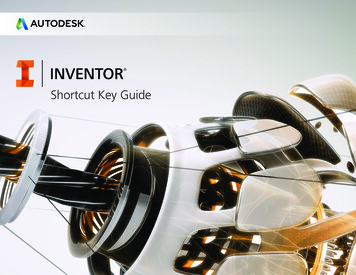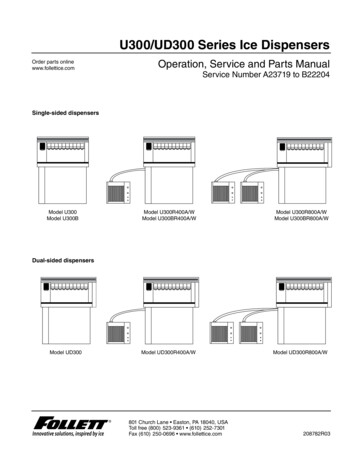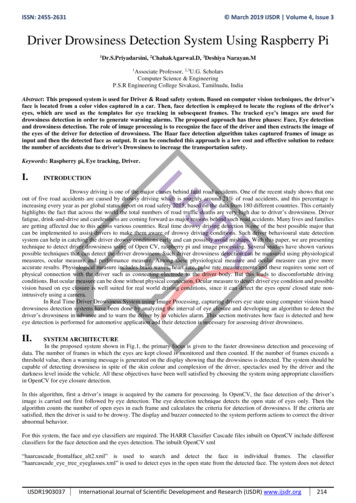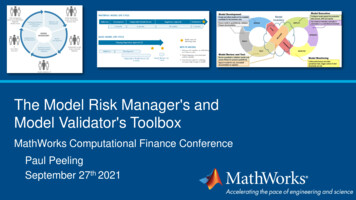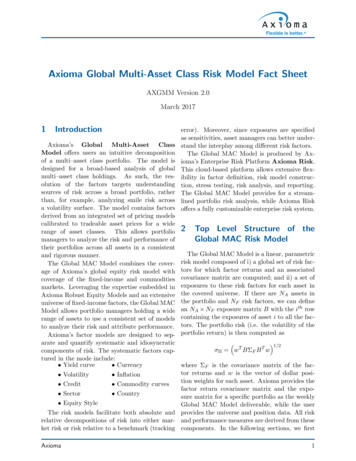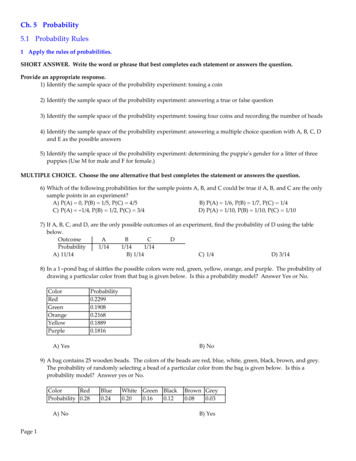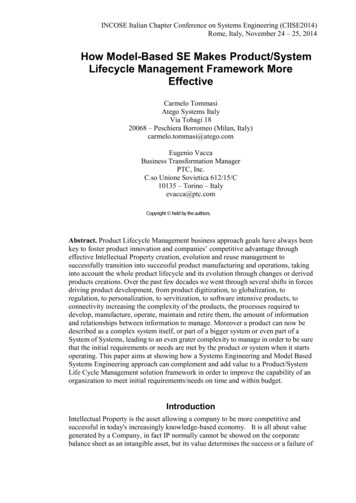
Transcription
INCOSE Italian Chapter Conference on Systems Engineering (CIISE2014)Rome, Italy, November 24 – 25, 2014How Model-Based SE Makes Product/SystemLifecycle Management Framework MoreEffectiveCarmelo TommasiAtego Systems ItalyVia Tobagi 1820068 – Peschiera Borromeo (Milan, Italy)carmelo.tommasi@atego.comEugenio VaccaBusiness Transformation ManagerPTC, Inc.C.so Unione Sovietica 612/15/C10135 – Torino – Italyevacca@ptc.comCopyright held by the authors.Abstract. Product Lifecycle Management business approach goals have always beenkey to foster product innovation and companies’ competitive advantage througheffective Intellectual Property creation, evolution and reuse management tosuccessfully transition into successful product manufacturing and operations, takinginto account the whole product lifecycle and its evolution through changes or derivedproducts creations. Over the past few decades we went through several shifts in forcesdriving product development, from product digitization, to globalization, toregulation, to personalization, to servitization, to software intensive products, toconnectivity increasing the complexity of the products, the processes required todevelop, manufacture, operate, maintain and retire them, the amount of informationand relationships between information to manage. Moreover a product can now bedescribed as a complex system itself, or part of a bigger system or even part of aSystem of Systems, leading to an even grater complexity to manage in order to be surethat the initial requirements or needs are met by the product or system when it startsoperating. This paper aims at showing how a Systems Engineering and Model BasedSystems Engineering approach can complement and add value to a Product/SystemLife Cycle Management solution framework in order to improve the capability of anorganization to meet initial requirements/needs on time and within budget.IntroductionIntellectual Property is the asset allowing a company to be more competitive andsuccessful in today's increasingly knowledge-based economy. It is all about valuegenerated by a Company, in fact IP normally cannot be showed on the corporatebalance sheet as an intangible asset, but its value determines the success or a failure of
a business, being Managers' ability to exploit these effectively and turn them to aprofit, so IP can affect the price of the stock.IP can include many items, such as Patents, Proprietary Technologies, etc. but,overall, include the skills, the knowledge and all relevant data that a company hasdeveloped about how to build its products/product lines or services; the contributionscome from individual employees or groups.Maintaining, increasing and extracting value from intellectual property andpreventing others from deriving value from it is an essential responsibility for anycompany.Initially, IP was managed mainly through paper based documents and processes, suchas requirements, specifications, drawings, etc. verified and approved through handwritten signatures, then in the mid ‘80s a first wave of transformation in themanufacturing industry led to the product DIGITIZATION, the IP was transformedfrom paper and physical assets to digital assets, replacing analog product and serviceinformation with a fully accurate virtual representation that can be easily leveragedacross the value chain (engineering, factory floor, service) and starting an evolutionwhich went though several other transformations up to the present days.Figure 1. Waves of manufacturing transformationsFollowing the digitization transformation we went through 6 additional waves ofevolution:1. GLOBALIZATIONThe general shrinking of the world driven by technology that eliminates economic andgeographical divisions and opens new markets.2. REGULATIONEnforcement of governmental rules, non-governmental organization policies andindustry standards related to environment, health, safety and trade.3. PERSONALIZATIONEfficiently tailoring products and services to accommodate regional and personalpreferences.
4. SOFTWARE-INTENSIVE PRODUCTSIntegrated systems of hardware and software capable of sophisticatedhuman-to-machine interaction, diagnostics and service data capture, with additionalvalue delivered through enhancements.5. SERVITIZATIONFundamental business model shift in which products evolve to integrated “bundles” ofservices capable of delivering new value continuously throughout the customerexperience lifecycle.6. CONNECTIVITYPervasive networks of “things” – often mobile – embedded with sensors andindividually addressable to enable sophisticated monitoring, control, andcommunication.Alongside the evolution waves a disciplined approach and supporting tools emergedto manage the lifecycle of products and the information created and consumed alongthe lifecycle, this approach and tools are recognized with the name of PLM or ProductLifecycle Management.The components of an effective PLM framework, able to effectively supportmanufacturers across the transformations, have extended the original classical PLMand CAD (Computer Aided Design) domains to SCM (Supply Chain Management),ALM (Application Lifecycle Management), SLM (Service Lifecycle Management)and IoT (Internet of Things) domains, as show in Figure 2.Figure 2. Extended PLM frameworkEach step in this evolution also brought with it an increased complexity in productsand systems definition as well as related IP management, leading to increasingdifficulties in getting the right products to the market, on time, within budget and atthe right price point.How can organizations cope with this increasing complexity of today systems, in ascenario where the market asks not just for products but also for configurable products
and services? The solution is augmenting the Extended Product LifecycleManagement framework, to transform it into a collaborative, multi-disciplinarySystems Engineering practice through the adoption of a fully embedded Model-BasedSystems Engineering methodology.Of course, this makes sense especially for complex products, and allows formallydescribing and designing a system since the start of requirements analysis phase.For the scope and objectives of this paper, we will analyze the components involved inthe management of the system definition process and information, describing thepositive impacts of adopting a MBSE/PLE approach to System Development.ContentWe will introduce the objectives of Manufactures in current market context and willexplain how the new Model Based approach extends the traditional PLM and SystemsEngineering vision.Then we will talk about our guiding principles and the 4 Systems Engineering visioncornerstones and will highlight that technical approaches on this extended SystemsEngineering vision need to be driven by industry, mainly the mission and safetycritical, embedded system industry.Manufacturers’ Objectives and Engineering ChallengesToday, as organizations struggle to produce more innovative products in the contextof the transformations the market went through, undoubtedly, they will continue toincrease the amount of software within those products, which will further drivecomplexity at levels much higher than before, especially taking into accounts the tightrequirements about safety imposed by national and international regulations.Organizations have driven significant improvements in the way they engineer anddeliver those products in order to address these trends. A key area for improvement isfostering a transformation from isolated systems, hardware, and software engineeringdisciplines to a collaborative, multi-disciplinary engineering practice, that begins withproduct requirements and continues throughout the lifecycle, conveying the followingset of engineering challenges: Ensuring customer needs are metReducing and mitigating program/product risksIncreasing reuse while supporting system/product variantsUnderstanding trade-offs between and across needs, requirements and systemperformancesThe most suitable way to confront those challenges for complex, safety criticalproducts and systems is a disciplined approach such as Systems Engineering.However, traditional Systems Engineering frameworks, as the one described by thepopular V-Model portrayed in Figure 3, are incomplete, missing important elements,which require system design activities in order to “enable the realization of successfulsystems” and to support all waves of manufacturing transformations. We defined andpropose a reference framework aiming at supporting the Total System LifecycleManagement, enabling true whole life support.
Figure 3. Traditional Systems Engineering frameworkSystem Lifecycle ManagementFigure 4 illustrates our proposal for the Extend Systems Engineering and LifecycleManagement framework, where the traditional Software, Mechanical andElectrical/Electronic disciplines are complemented by the Manufacturing and Serviceplanning streams, which become part of the concurrent engineering process under thecontrol of the Systems Engineering methodology.Figure 4. Extended Systems Engineering and Lifecycle ManagementframeworkThe framework extends its coverage to the manufacturing, operations and in-servicephases of the lifecycle (up to the retirement, if needed) taking advantage of thepossibility to connect smart, software enriched products through sensors gathering
product and surrounding environment parameters or through actuators, enabling thepossibility to monitor, operate and service smart products remotely, and, in somecases, enabling products to self-heal or self-adapt to operating conditions.In the Extended Systems Engineering framework we move the manufacturingplanning and service planning processes upstream, so that organizations are in a betterposition to deliver on-time and on budget, considering as early as possible the impactsof design decisions on downstream processes.For many organizations, Manufacturing and/or Service activities are outsourced orcarried on by separate legal entities; nevertheless, they must be considered highlyintegrated processes to allow for optimal system performances design across thelifecycle. Like for traditional concurrent engineering activities involving software,mechanical and electrical/electronic components of the product organizations mustempower and support collaboration across geographical dispersed teams formanufacturing and service planning and execution teams, also.Like the traditional V-Model SE framework, the Extended Framework supports aprocess involving decomposing the systems into subsystems and components andguides through the flow of requirements analysis, system/subsystem/componentdesign, development, integration and test.Within this framework Model Based Systems Engineering is of uttermost importanceduring the requirements management and system architecture definition phases, alsoenabling very early stage system simulation activities, allowing to analyze and takebest possible decisions about functional, RAMS (A. Garro, A. Tundis, 2012) andperformance requirements trade-offs.Moreover, the use of a MBSE approach enables practices such as Set Based Design,being adopted, for example, by the U.S. Navy for complex systems acquisitionprograms such as the Ship-to-Shore Connection (SSC), to increase the chances todefine an optimal system solution for the required capabilities (D. J. Singer, N.Doerry, M. E. Buckley, 2009).Benefits and contribution of MBSE extends to the verification and operation phases ofthe System Lifecycle, allowing to define Verification and Validation procedures aswell as formally describing operating procedures and supporting training activities(Friedenthal, Sanford et al. 2007)MBSE-Enabled Extended FrameworkTo successfully enhance the Extended Systems Engineering and LifecycleManagement framework with MBSE methodology and overcome Manufactures’engineering challenges 4 elements are the cornerstone of an effective solution andmust work together seamlessly, integrating the processes, the people – with relatedorganizations – and the technologies enabling the automation of process andfacilitating the activities of systems engineers and other participant roles in creatingand managing the product information and their relationships throughout the SystemLifecycle. These cornerstones are shown in Figure 5 and detailed in Figure 6.
Figure 5. The 4 cornerstones for an MBS-enabled PLM frameworkovercoming Manufacturers’ engineering challenges1. Model-Based Systems Engineering. This is obviously one of the components andit is meant to manage the System Architecture and the UML/SysML/UPDM Modelmethodology in a collaborative way, supporting a multi-user, multi-location modelauthoring and sharing, even among geographically dispersed design teams. Thanks tothe common repository a full consistency is ensured, providing enterprise visibility tofunctions, interfaces and all model elements with their relationships. A real-time fulltraceability is a key element for an error-free model design.2. System Requirements and Validation. Customer needs are elicited early in thedevelopment cycle and come from different sources, like external requirementmanagement tools, general-purpose tools like MS Word or MS Excel, etc. Throughthis framework component, it is possible to import external requirements from themost common formats (ReqIF, MS Word, Excel, etc.), and then analyze, decompose,detail, trace them through system development. It is also key to enable the continuousvalidation of lifecycle assets from requirements to test as they are created and changedand verify as-designed and as-built product against requirements and validate itactually meets initial needs throughout operations.The adoption of a MBSE approach improves this component allowing the creation ofa link between unstructured, informal requirements and a formal, suitable forsimulation, definition of the same requirements.Moreover MBS enable system engineers to formally define system requirements andperformance targets from high level needs, creating a early formal view of the solutiondomain, directly linked to the problem domain which may be described informally.Another added value of MBSE for the Systems Engineering and Validationcomponent is the capability to design and document early test cases and allow todefine and simulate system components’ behavior to start verification activities veryearly in the development cycle, thus allowing for maximum efficiency in analyzingperformances and requirements trade-offs easily enabling early analysis of multiplesolutions at once.
Figure 6. Content of the 4 cornerstones3. X-Disciplines Coordination. A complex system is made up by the means ondifferent disciplines: mechanics, electromechanical, electronics, software, etc. Beingextremely successful and effective in one discipline and lousy in the others lead to lessthen optimal system performances and, possibly, to failure. It is key to take advantageof high value collaboration between mechanical, electrical & software as well asmanufacturing and service engineering to be fully successful in designing complexsystems across multiple disciplines and interchange all the data in an easy, error-freeway.Collaboration must be ensured also in order to control the system configuration as itevolves through changes requested by participants in the system developmentprocess, such as marketing, manufacturing, customer or design, tracing the changeprocess and evaluate their impacts on system quality, services, functions andinterfaces, as well as enable cost impacts estimation on system TCO (Total Cost ofOwnership).MBSE enhances this component improving the ability to easily correlate: the needs and requirementsthe functions and related behaviorthe interfacesthe physical structurecreating a bridge between a usually highly unstructured and informal definition of thesystem (needs and requirements) and a very formal and structured description (theproduct structure an related information needed to describe it, build it, quality controlit, etc.) and keeping those relationships up to date throughout system modifications,facilitating change impacts analysis and reducing errors discovered at late stages ofdevelopment.
4. Product Line Engineering. Mass customization and best matching differentsolutions for the same class of problems require the capability to reuse as much aspossible existing subsystems, components and engineering artifacts as well as manageproduct platforms and product lines, optimizing the costs in order to satisfy multipleneeds with matching product and system variants.The possibility to identify from the start the commonalities and develop at oncemultiple versions of the same system, defined by a set of options and rules based onoption choices, for all disciplines is fundamental in order to govern the amount ofinformation needed to define, design, manufacture, test, operate and service all thepossible variants in an efficient way.The use of formal, modeling, methods, such as OVM (Orthogonal Variant Modeling)from PALUNO – The Ruhr Institute of Software Technology, coupled with classicalPLM product configurators enable the possibility to manage the design and definitionof system variants across the whole lifecycle, allowing to define a set of choicesidentifying a specific system variant and filtering all the relevant information for thatspecific variant at once, including needs, requirements, functions, activities, tasks,interfaces, software, physical design, build instructions, service manuals, etc.These components, which are not exhaustive of the whole framework but are the mostimpacted by the introduction of a MBSE approach, improve collaboration acrossdisparate and geographically/functionally dispersed design teams, shortendevelopment cycles, allow to achieve higher product quality, faster time to market,and, overall, increased design reuse.ConclusionsDevelopment and operation of complex systems requires a disciplined approach.Extending a traditional PLM framework through adoption of Systems Engineeringand Model-Based Systems Engineering methodologies multiplies its typical benefitsof increasing product quality, reducing Time to Market and increase the number ofsuccessful product launches.Analysts and researchers agree on Systems Engineering effectiveness and the valueadded of Model Based Systems Engineering.Boeing found that the most rigorous systems engineering practices applied to the mostcomplex system enables the completion of the project in ½ the time when comparedwith the least complex system manufactured with the least rigorous systemsengineering practices. (E. C. Honour, 2004).Aberdeen Group found (2012) that leading companies are 50% more likely than theirpeers to credit success to effective systems engineering. Gains recorded include: Met 88% of quality targets Met 86% of revenue targets Met 85% of product launch targets
12% decrease in development time over previous years 9% increase in profit margins on new products.A model-based approach to product line engineering delivers 23% more projects ontime, at 62% lower cost, than alternatives – based on a survey of 667 engineeringrespondents conducted by analyst firm Embedded Market Forecasters (J. lectualPropertySomething (such as an idea,invention, or process) thatcomes from a person's ineering MBSEMBSE is the formalizedapplication of modeling tosupport system requirements,design, analysis, verificationand validation, beginning inthe conceptual design phaseand continuing throughoutdevelopment and later lifecycle phasesINCOSE MBSEInitiativeProduct LifecycleManagement(PLM)A strategic business approachthat applies a consistent set ofbusiness solutions in supportof the collaborative creation,management, dissemination,and use of product definitioninformation across theextended enterprise fromconcept to end oflife—integrating people,processes, business systems,and informationCIMdata – “PLM– Empoweringthe Future ofBusiness” reportSystemsEngineeringSE is an interdisciplinaryapproach and means to enablethe realization of successfulsystemsINCOSE SystemsEngineeringHandbook v.3.2.2, page 6ReferencesAberdeen Group 2012. “The Strategic Role of Systems Engineering: Ensure the FutureSuccess of Your Products” Aberdeen Group ReportCIMData 2010. “Product Lifecycle Management – Empowering the Future of Business”CIMdata Report
Friedenthal, Sanford et al. 2007. “INCOSE Model Based Systems Engineering (MBSE)Initiative” INCOSE 2007 (San Diego, CA, US).Garro, Alfredo and Tundis, Andrea 2012. “A Model-Based Method for System ReliabilityAnalysis” SpringSim 2012 (Orlando, FL, US)L. Rogovchenko-Buffoni, P. Fritzson, A.Garro, A. Tundis, and M. Nyberg, RequirementVerification and Dependency Tracing During Simulation in Modelica, Proceedings ofthe 8th EUROSIM Congress on Modelling and Simulation (EUROSIM 2013), Cardiff,Wales, UK, 10-13 September, 2013.Honour, Eric 2004. “Understanding the Value of Systems Engineering” INCOSE SECOEKrashner, Jerry 2014. “How Development Organizations can Achieve Long-Term CostSavings Using Product Line Engineering (PLE)” Embedded Market Forecasters ReportPorter, Michael and Heppelmann, Jim 2014. “How Smart, Connected Products areTransforming Competition” Harvard Business Review, Nov. 2014PTC eBook, 2012. “Forces of Transformation” (Available ation)SE Handbook Working Group 2011, “SYSTEMS ENGINEERING HANDBOOK” v3.2.2,INCOSESinger, David et al. 2009. “What is Set-Based Design?” ASNE DAY 2009, National Harbor,MD.
to manage the lifecycle of products and the information created and consumed along the lifecycle, this approach and tools are recognized with the name of PLM or Product Lifecycle Management. The components of an effective PLM framework, able to effectively support manufacturers across the transformations, have extended the original classical PLM

